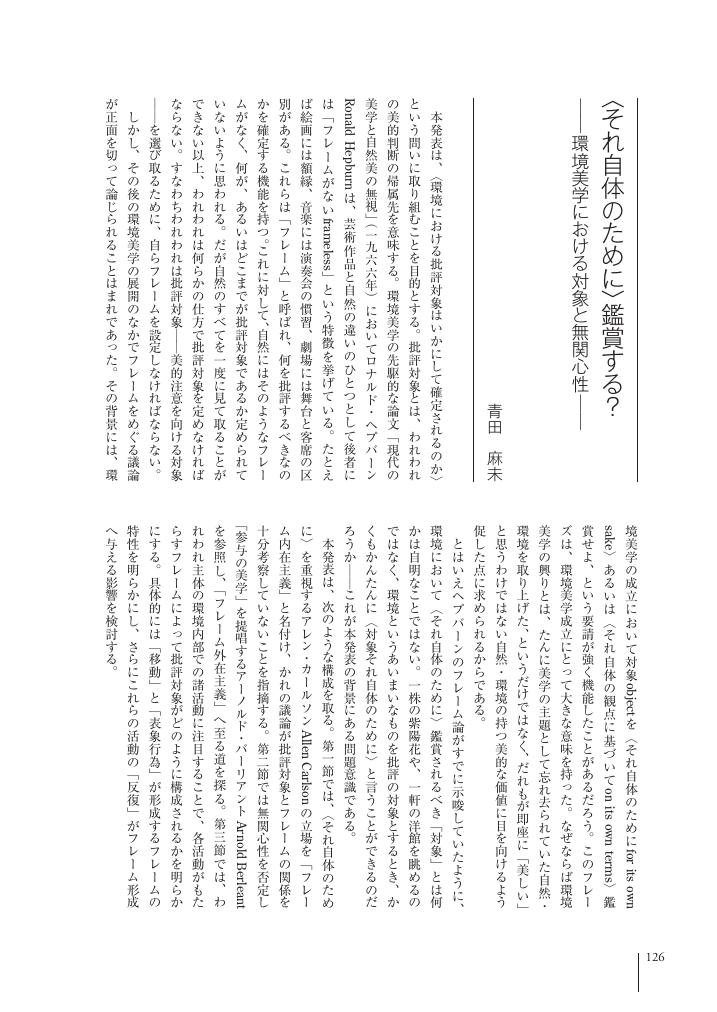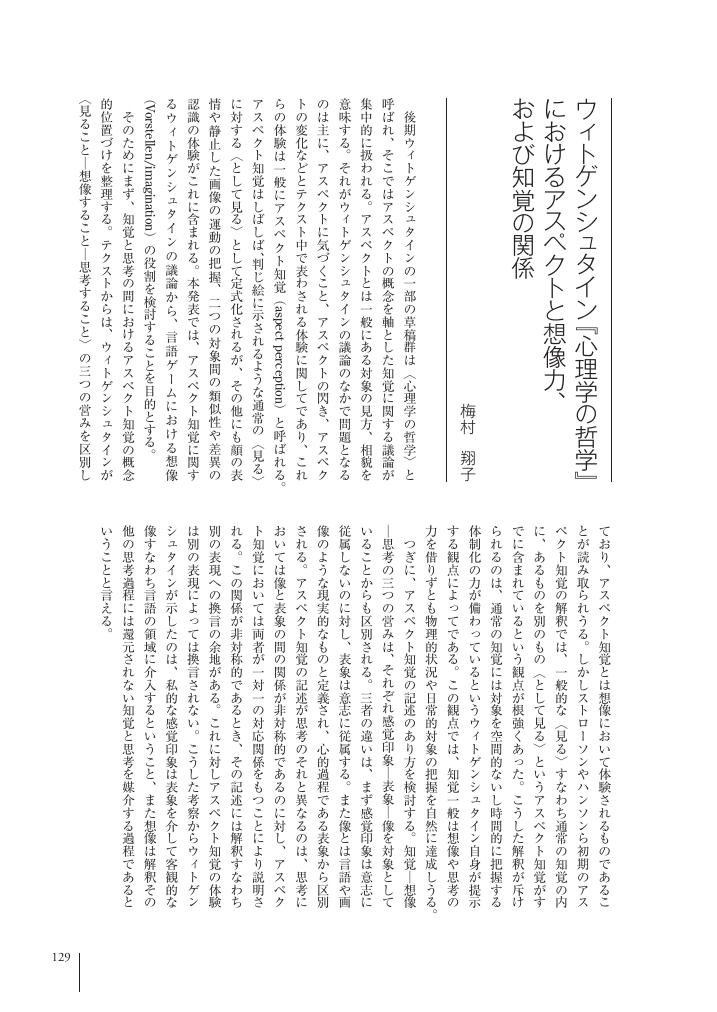1 0 0 0 OA アルカディアの望遠鏡 ドナート・クレーティの《天体観測》をめぐる新しい提案
- 著者
- 高橋 健一
- 出版者
- 美学会
- 雑誌
- 美学 (ISSN:05200962)
- 巻号頁・発行日
- vol.68, no.2, pp.137, 2017 (Released:2019-01-02)
1 0 0 0 OA 条件付き連鎖主義の意義と課題 ジェロルド・レヴィンソン『瞬間の中の音楽』の批判的検討
- 著者
- 田邉 健太郎
- 出版者
- 美学会
- 雑誌
- 美学 (ISSN:05200962)
- 巻号頁・発行日
- vol.68, no.2, pp.138, 2017 (Released:2019-01-02)
1 0 0 0 OA 「めづらし」/「あたらし」 中世和歌における価値判断の変遷と独創性の出自
- 著者
- 土田 耕督
- 出版者
- 美学会
- 雑誌
- 美学 (ISSN:05200962)
- 巻号頁・発行日
- vol.68, no.2, pp.139, 2017 (Released:2019-01-02)
1 0 0 0 OA 一九六〇年代アメリカにおける「シュルレアリスト」としてのルネ・マグリット受容
- 著者
- 利根川 由奈
- 出版者
- 美学会
- 雑誌
- 美学 (ISSN:05200962)
- 巻号頁・発行日
- vol.68, no.2, pp.140, 2017 (Released:2019-01-02)
1 0 0 0 OA バンベルク大聖堂聖ゲオルギウス内陣北障壁の考察 花嫁としてのマリアの戴冠のプログラム
- 著者
- 仲間 絢
- 出版者
- 美学会
- 雑誌
- 美学 (ISSN:05200962)
- 巻号頁・発行日
- vol.68, no.2, pp.141, 2017 (Released:2019-01-02)
1 0 0 0 OA 〈それ自体のために〉鑑賞する? 環境美学における対象と無関心性
- 著者
- 青田 麻未
- 出版者
- 美学会
- 雑誌
- 美学 (ISSN:05200962)
- 巻号頁・発行日
- vol.68, no.2, pp.126, 2017 (Released:2019-01-02)
1 0 0 0 OA 環境芸術は自然に対する美的侮辱か 環境芸術をめぐる倫理的問題について
- 著者
- 伊東 多佳子
- 出版者
- 美学会
- 雑誌
- 美学 (ISSN:05200962)
- 巻号頁・発行日
- vol.68, no.2, pp.127, 2017 (Released:2019-01-02)
1 0 0 0 OA ウィトゲンシュタイン『心理学の哲学』 におけるアスペクトと想像力、 および知覚の関係
- 著者
- 梅村 翔子
- 出版者
- 美学会
- 雑誌
- 美学 (ISSN:05200962)
- 巻号頁・発行日
- vol.68, no.2, pp.129, 2017 (Released:2019-01-02)
1 0 0 0 OA 中心概念の創出 「亡命芸術家」展(一九四二)を巡るアートシーンの変容
- 著者
- 長名 大地
- 出版者
- 美学会
- 雑誌
- 美学 (ISSN:05200962)
- 巻号頁・発行日
- vol.68, no.2, pp.130, 2017 (Released:2019-01-02)
1 0 0 0 OA 小津映画の「無人のショット」に対する同時代批評の検討
- 著者
- 具 慧原
- 出版者
- 美学会
- 雑誌
- 美学 (ISSN:05200962)
- 巻号頁・発行日
- vol.68, no.2, pp.131, 2017 (Released:2019-01-02)
1 0 0 0 OA ジャン・デュビュッフェにおける物質性 一九四五~五〇年代初頭「厚塗り」絵画をめぐって
- 著者
- 小寺 里枝
- 出版者
- 美学会
- 雑誌
- 美学 (ISSN:05200962)
- 巻号頁・発行日
- vol.68, no.2, pp.132, 2017 (Released:2019-01-02)
1 0 0 0 OA 香港アクション映画が描く身体 『ブレード/刀』を中心とした理論的考察
- 著者
- 雑賀 広海
- 出版者
- 美学会
- 雑誌
- 美学 (ISSN:05200962)
- 巻号頁・発行日
- vol.68, no.2, pp.133, 2017 (Released:2019-01-02)
1 0 0 0 OA ジャン=レオン・ジェローム《アウグストゥスの時代》再考 同時代批評と美術政策を踏まえて
- 著者
- 齊藤 大貴
- 出版者
- 美学会
- 雑誌
- 美学 (ISSN:05200962)
- 巻号頁・発行日
- vol.68, no.2, pp.134, 2017 (Released:2019-01-02)
- 著者
- 佐々木 秀憲
- 出版者
- 美学会
- 雑誌
- 美学 (ISSN:05200962)
- 巻号頁・発行日
- vol.68, no.2, pp.135, 2017 (Released:2019-01-02)
- 著者
- 桑原 夏子
- 出版者
- 美学会
- 雑誌
- 美学 (ISSN:05200962)
- 巻号頁・発行日
- vol.68, no.2, pp.25, 2017 (Released:2019-01-02)
My paper shows one of the textual sources for the wall painting of the temple of Fortuna Virile (the church of Santa Maria di Secundicerio) (Italy, Rome, 872-882) which presents the Marian cycle with her last days, the story of St. Basil and the story of Mary of Egypt. This is the oldest example, which presents the Last Days of the Virgin Mary - the Annunciation of the Death of the Virgin by Christ, the Departure of the Apostles, and the Arrival of the Apostles - therefore it is important to discover its textual source. First of all, I point out that one of the Apostles is departing from his grave to attend Mary’s death in the scene of the Departure of the Apostles. Secondly, I indicate that this unique episode is found in a Greek text, which is written by pseudo St. John in the early 6th century. All stories of this temple are based on the Greek texts, therefore this wall painting might suggest the lost Greek visual culture has been persecuted by iconoclasm in the Byzantine Empire.
- 著者
- 江藤 匠
- 出版者
- 美学会
- 雑誌
- 美学 (ISSN:05200962)
- 巻号頁・発行日
- vol.68, no.2, pp.49, 2017 (Released:2019-01-02)
Pietro Perugino wurde in den 1480er-Jahren von Theologen Baltori ein Altarwerk in Rom in Auftrag gegeben. Diese Kreuzigung, die nach ihrem Besitzer Fürsten Galizin Galitzin-Triptychon genannt wurde, ist eine Verbindung von den meditativen Bildthemen mit der naturalistischen Ästhetik. Schon wiesen F.Hartt und J.Wood auf einen großen Einfluß der niederländischen Malerei auf das Altarbild Peruginos hin. Aber sie nahmen keine Notiz von den gefühlvollen Figurendarstellungen von Hl.Maria und Hl.Johannes. Der Verfasser bemerkte die Ähnlichkeit zwischen dieser Figurendarstellung des Hl.Johannes und derjenigen in dem Triptychon von Niccolò da Foligno in der Pinacoteca Vaticana. Die Kreuzigung Niccolòs hat eine Zusammanhang mit derjenigen der Eyckischen Schule in der Cà d’Oro zu Venedig. Es ist bewährt, dass die Figurenkomposition dieser Kreuzigung das Abbild von der Kreuzigungsminiatur in jenen Heures de Milan ist. Niccolò da Foligno wird als einer der Meister Peruginos in seiner Umbrien-Zeit betrachtet. Aus diesem Grunde kommt es zu dem Schluß, dass Perugino für die Darstellung der Galitzin-Kreuzigung auch das Vorbild der Eyckischen Schule verwendet hat. Peruginos Altarbild konnte deswegen die Doppelfunktion eines Andachtsbildes erfüllen: die religiöse Versenkung und den optischen Charme.
1 0 0 0 OA ドルマバフチェ・ジャーミイにみられるオスマン帝国ドーム式モスクの様式的伝統の存続
- 著者
- 瀧川 美生
- 出版者
- 美学会
- 雑誌
- 美学 (ISSN:05200962)
- 巻号頁・発行日
- vol.68, no.2, pp.61, 2017 (Released:2019-01-02)
Bezmiâlem Valide Sultan Mosque (commonly known as Dolmabahçe Mosque, 1852- 1855, Istanbul) has not been properly valued in the history of Ottoman architecture. The prevalent view is that Ottoman mosques of the 18th and 19th centuries degenerated from the Golden Age because more importance was attached to decoration rather than structure under European influences, thereby breaking with the Ottoman tradition. However, this mosque shares, along with European elements, the following essential characteristics with the Ottoman mosques of the Golden Age: (1) The unified space of the prayer hall formed by the single dome without any elements dividing the space; (2) the effects of the surroundings and the opening of the prayer hall, as well as the overall construction of the mosque; and (3) The rectangle form topped by a semicircle found in every part of the mosque, like the building’s form, windows, piers, and arches, among others.
1 0 0 0 OA ドガの風景画にみられる新たな視覚 サン=ヴァレリ=シュル=ソンムの風景画を中心に
- 著者
- 藤本 奈七
- 出版者
- 美学会
- 雑誌
- 美学 (ISSN:05200962)
- 巻号頁・発行日
- vol.68, no.2, pp.73, 2017 (Released:2019-01-02)
Degas, famous for his dancer paintings, also intensively worked on landscapes in 1869, 1890-93 and c.1895-98. Previous studies emphasized elements of next-generation art such as Fauvism or Cubism appear in the arbitrary colors and distorted space in the landscapes depicted in Saint-Valéry-sur-Somme during the period of c.1895-98. This paper, first, compares the landscapes of c.1895-98 with of 1892 depicting scenery from moving train compartment. In the landscapes of 1892, it is clear that description of the foreground is vaguer than that of the background for speed of a train, and we can argue that this is also the case with the landscapes of c.1895-98. Second, through comparison of four Saint-Valéry-sur-Somme landscapes depicting the identical place with actual view, it will be shown that Degas drew them changing his standing locations on the same road. Seeing these in certain order, we have the impression that we walk further and further on the road as the hindmost house in each landscape is getting bigger. Thereby, it is concluded that Degas captured not only moving objects like dancers and racehorses but still objects which change by his move. Representation of such to-andfro motion is unique among his other landscapes.
1 0 0 0 OA 武満徹における反復記号の使用法 同時代の作品からの影響とその美学の変化
- 著者
- 原 塁
- 出版者
- 美学会
- 雑誌
- 美学 (ISSN:05200962)
- 巻号頁・発行日
- vol.68, no.2, pp.109, 2017 (Released:2019-01-02)
This paper clarifies Japanese composer Toru Takemitsu’s usage of the repeat sign and considers the influence of other works from the same period and his aesthetic change. In the 1960s, Takemitsu uses the repeat sign in two ways. One of the usages works as the base of “Tone Cluster” and introduces high level “Indeterminacy”. The other is inspired by the technique of the Polish composer Witold Lutosławski and introduces low level “Indeterminacy” under the control of the composer. In the latter case, the repeat sign enables each player to play independently and creates the asynchronous sound. This usage is continued in the next decade. In the 1970s, a number of passages in which different cycles and tempi accumulate simultaneously are repeated. In spite of his instruction of tempi and notes, the entire sound cannot be predicted exactly, as each passage is repeated many times, so this repetition also introduces a controlled “Indeterminacy”. In the 1980s, Takemitsu came close to Steve Reich’s “Phase-Shifting” technique. Reich’s technique implies strong “Determinacy”, and thus we can see the change in Takemitsu’s aesthetic here. While in prior works, he placed more value on “Indeterminacy”, in this period, he treated “Determinacy” and “Indeterminacy” relatively.
1 0 0 0 OA レイモン・アンス+ジャック・ヴィルグレにおけるデコラージュの契機とその意味の変遷
- 著者
- 神地 伸充
- 出版者
- 美学会
- 雑誌
- 美学 (ISSN:05200962)
- 巻号頁・発行日
- vol.68, no.1, pp.138, 2017 (Released:2018-07-01)














